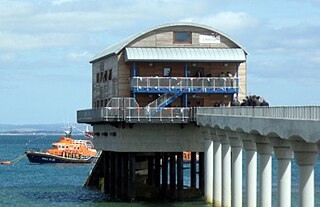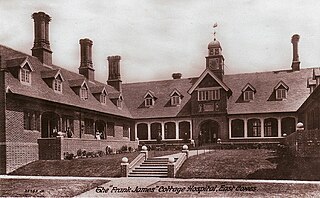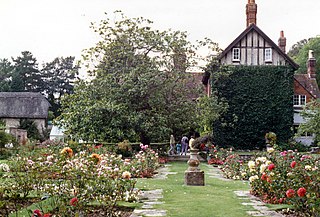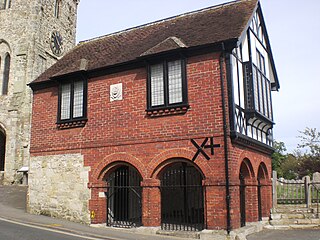
Sandown is a seaside resort town and civil parish on the south-east coast of the Isle of Wight, England. The resort of Shanklin and the settlement of Lake are sited just to the south of the town. Sandown has a population of 11,654, according to the 2021 Census; together with Shanklin and Lake, it forms a built-up area of around 25,000 inhabitants. It is the northernmost town of Sandown Bay, with an easily accessible, sandy shoreline with beaches that run continuously from the cliffs at Battery Gardens in the south to Yaverland in the north.

Bembridge is a village and civil parish located on the easternmost point of the Isle of Wight. It had a population of 3,848 according to the 2001 census of the United Kingdom, leading to the implausible claim by some residents that Bembridge is the largest village in England. Bembridge is home to many of the Island's wealthiest residents. The population had reduced to 3,688 at the 2011 Census.

The ancient 'Kynges Towne' of Brading is the main town of the civil parish of the same name. The ecclesiastical parish of Brading used to cover about a tenth of the Isle of Wight. The civil parish now includes the town itself and Adgestone, Morton, Nunwell and other outlying areas between Ryde, St Helens, Bembridge, Sandown and Arreton. Alverstone was transferred to the Newchurch parish some thirty years ago.

Nunwell is the location of Nunwell House, near Brading on the Isle of Wight, which was the home of the Oglander family for many centuries. It is in the civil parish of Brading. The present family are not direct descendants through the male line and thus the baronetcy has died out.

Brading railway station is a Grade II listed railway station serving Brading on the Isle of Wight, England. It is located on the Island Line from Ryde to Shanklin. Owing to its secluded countryside location, it is one of the quietest stations on the island.

Sandown Castle was a Device Fort built at Sandown on the Isle of Wight by Henry VIII in 1545 to protect against the threat of French attack. Constructed from stone with angular bastions, its design was a hybrid of Italian military architectural thinking with traditional English military design. The site was raided by a French force that summer while the fortification was still being constructed. The site suffered from coastal erosion and the castle was demolished in 1631.

Yaverland is a village and former civil parish, now in the parish of Sandown, on the Isle of Wight, England. It is just north of Sandown on Sandown Bay. It has about 200 houses. About 1⁄3 of a mile away from the village is the Yaverland Manor and Church. Holotype fossils have been discovered here of Yaverlandia and a pterosaur, Caulkicephalus. The White Air extreme sports festival was held annually at Yaverland pay and display car park between 1997 and 2008, but moved to Brighton for 2009.

Brading Roman Villa was a Roman courtyard villa which has been excavated and put on public display in Brading on the Isle of Wight.
The 1st Isle of Wight Rifle Volunteers, later the 8th Battalion, Hampshire Regiment, but known informally as the 'Isle of Wight Rifles', was an auxiliary unit of the British Army formed to defend the Isle of Wight after a mid-19th Century invasion scare. During World War I it fought in the Gallipoli Campaign, taking part in the calamitous attack at Suvla Bay, and later at the battles of Gaza and Megiddo in Palestine. Between the wars it was converted to coast defence artillery and served in this role on the Isle of Wight throughout World War II. One battery was sent to reinforce the garrison of Tobruk, where it was captured in 1942. Postwar the unit converted to the air defence role, then reverted to infantry, and its successors continue in today's Army Reserve.

Sandown Pier is a pleasure pier in Sandown, Isle of Wight, England.

Northwood House is a country manor house in Cowes on the Isle of Wight in the United Kingdom. The current building dates back to 1799 and was built for the London businessman George Ward, remaining in his family for five generations. It is a Grade II listed building, said to have a ground floor area of around 15,000 square feet.

St Mary's Church is a parish church in the Church of England located in Brading, Isle of Wight.
The 2011 Island Games on the Isle of Wight was the 12th edition in which a football tournament was played at the multi-games competition. It was contested by 15 teams.

The Frank James Hospital is a currently closed hospital in Adelaide Grove, East Cowes on the Isle of Wight. It was sold by the NHS Trust in 2002 and since then, it has had ownership issues, which has led to its vandalism and disrepair. The building is currently on the endangered buildings list for the United Kingdom. It has a central block with two projecting wings and a verandah to the ground floor on all sides. It is built of red brick, with a tiled roof and has been Grade II listed since 1979.

Morton Manor is a manor house originating in the 13th century, in Brading, Isle of Wight, England. It is located 1 mile (1.6 km) southwest of Sandown Road. The fairly small 14th-century house was modified in the 19th century. Constructed of varied materials, it was refurbished and extended in the early 20th century in an Arts and Crafts style. The house has a Tudor fireplace in the dining room, with William De Morgan green glazed tiles, and the manor includes a small museum of rural life.

Nunwell House, also Nunwell Manor, is a historic English country house in Brading, Isle of Wight. Located 3 miles (4.8 km) south of Ryde, the Tudor and Jacobean style house also has later additions. The house contains family militaria. It was occupied by the Oglander family from Norman times. Nunwell House is a Grade II* listed building.
Merston Manor is a manor house in Merstone on the Isle of Wight, England. The manor was first mentioned in the Domesday Book. Prior to the Norman Conquest, Merston Manor was owned by the Brictuin family. The present home, built in 1605 in the Jacobean style by Edward Cheeke, was rebuilt in the Victorian era. This structure may be the oldest brick house on the Island. The manor now belongs to the Crofts family.

The Drill Hall Road Army Reserve Centre is a military installation in Newport, Isle of Wight.

The Old Town Hall is a municipal building in the High Street, Brading, Isle of Wight, England. The structure, which is now used to store and exhibition a collection of artefacts and records, is a Grade II listed building.


















